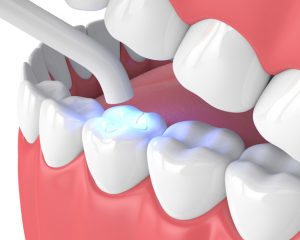Don’t Let Cavities Go Untreated
Cavities are more than minor inconveniences; they can lead to serious dental issues if left untreated. Dental fillings offer a simple and effective solution to halt the progression of decay and restore the integrity of your teeth.
At the San Luis Obispo, CA, the dental practice of Dr. Carrie Ramirez, we offer dental fillings to help you say goodbye to the discomfort and potential complications of untreated cavities. To schedule your appointment with our SLO, CA, dentist, contact our dental office today by calling (805) 549-8483.
What Are Dental Fillings? 
Dental fillings restore and repair teeth affected by decay or damage. When a tooth develops a cavity (dental caries), a small hole is caused by decay, and a dental filling is used to fill the cavity and prevent further decay or infection. A dental filling can also be used to repair teeth damaged due to trauma or wear.
With dental fillings, our dentist can help patients with:
- Restoring the structural integrity of the tooth, preventing further decay and damage.
- Alleviating tooth sensitivity and pain associated with cavities or damaged teeth.
- Improving the appearance of the tooth, especially when tooth-colored materials are used.
- Preserving the tooth’s function and aesthetics for years to come.
Types of Dental Fillings
Composite Fillings
Composite fillings, also known as tooth-colored fillings, are made of plastic and glass particles. They’re tooth-colored and blend in with the natural teeth, making them a popular choice for visible areas of the mouth. Composite fillings bond directly to the tooth structure, providing good support. A composite filling is less durable than amalgam fillings and may need to be replaced over time.
Amalgam Fillings
Also known as silver fillings, amalgam fillings are made of metals, including silver, tin, copper, and mercury. They’re durable and have been used for many years. However, their silver color makes them more noticeable, which can be a concern for some patients.
Ceramic Fillings
These fillings are made of porcelain or ceramic materials. They’re tooth-colored and offer excellent aesthetics. Ceramic tooth fillings also are highly resistant to staining and are well-suited for areas of the mouth that require strength and durability.
Gold Fillings
Gold fillings are made of gold alloy, a mixture of gold, and other metals like silver and copper. They’re highly durable and can last for many years. Gold fillings are custom-made in a dental laboratory and are more expensive than other fillings.
Glass Ionomer Fillings
Glass ionomer fillings are a mixture of acrylic and glass materials. They release fluoride, which helps to prevent further tooth decay. Glass ionomer fillings are often used in children or for non-load-bearing areas of the teeth.
Benefits of Dental Fillings
Dental fillings are a common dental procedure that addresses cavities and tooth decay. But beyond just fixing a hole, fillings offer a range of advantages for your oral health and overall well-being. Here’s a closer look at the benefits:
- Stops Decay in its Tracks: The primary function of a filling is to remove decayed tooth material. This eliminates the breeding ground for cavity-causing bacteria, preventing further damage and the need for more extensive procedures down the line.
- Preserves Your Natural Tooth: Early intervention with fillings allows you to keep your original tooth structure. This is important for maintaining a healthy bite, proper chewing function, and a natural appearance.
- Restores Biting and Chewing: Cavities can weaken teeth and make chewing uncomfortable. Fillings restore the tooth’s structure and function, allowing you to enjoy a wider variety of foods without pain or difficulty.
- Pain Relief: Cavities can cause sensitivity and pain, especially when exposed to hot or cold. Fillings eliminate these irritations, providing immediate pain relief and improving overall comfort.
- Boosts Your Smile Confidence: Modern fillings come in tooth-colored materials that blend seamlessly with natural teeth. This can significantly improve the aesthetics of your smile, promoting feelings of confidence and self-esteem.
- Durable and Long-lasting: Dental fillings are designed to withstand the wear and tear of everyday chewing. With proper care, some fillings can last for over 15 years.
- Easy Maintenance: Once placed, fillings require the same routine of brushing, flossing, and regular dental checkups as your natural teeth. There’s no special care needed to maintain your fillings.
- Relatively Quick Procedure: Getting a filling is usually a quick and straightforward procedure, often completed in a single visit. This minimizes disruption to your daily routine.
- Minimal Post-Op Discomfort: While there might be some slight sensitivity after the procedure, fillings typically require minimal recovery time. Discomfort can be easily managed with over-the-counter pain relievers.
- Prevents Fractures: Cavities weaken teeth, making them more susceptible to cracks and fractures. Fillings reinforce the tooth structure, reducing the risk of further damage.
- Cost-Effective Solution: Compared to more complex procedures for neglected cavities, fillings are a cost-effective way to address tooth decay and maintain oral health.
Do You Need Dental Fillings?
To determine your need for dental fillings, our general dentists will evaluate the following:
- Presence of a Cavity: Dental fillings are primarily used to treat cavities. The first thing we’ll look for is the existence of a cavity in a tooth. X-rays and a visual examination help our dentist identify the extent of the decay.
- Tooth Structure: The extent of the damage to the tooth structure is crucial. Dental fillings are typically recommended for minor to moderate decay. If the decay is too extensive, other treatments like dental crowns or root canals may be necessary.
- Patient’s Overall Health: A patient’s health and medical history are considered. Certain medical conditions or medications may affect the choice of filling material or the patient’s ability to undergo the procedure.
- Allergies or Sensitivities: Some individuals may have allergies or sensitivities to specific dental materials used in fillings. Dentists must consider these factors when selecting the appropriate filling material.
- Adequate Tooth Structure for Support: There must be enough healthy tooth structure remaining to support the filling. If the tooth is severely compromised, you may not be a suitable candidate for a filling, and alternative treatments may be necessary.
The Dental Filling Process
Our San Luis Obispo dentist will start the dental filling process by numbing the area around the tooth to ensure you’re comfortable during the procedure. Next, we’ll use a dental drill or laser to remove the decayed portion of the tooth, leaving a clean and prepared area.
Once the decay is removed, Dr. Ramirez will carefully shape the cavity to create space for the filling material. The chosen filling material, such as composite resin, dental amalgam, or porcelain, is then placed into the prepared cavity and shaped to match the natural contours of the tooth. The filling is hardened using a curing light.
After ensuring the proper fit and bite alignment of your newly filled tooth, we’ll make any necessary adjustments. The final step involves polishing the tooth filling itself to achieve a smooth and natural appearance. The result is a restored tooth that’s both functional and aesthetically pleasing while preventing further decay.
How Much Do Dental Fillings Cost?
On average, a dental filling costs between $50 to $250. However, certain factors will affect the total cost of your filling treatment, such as the type of dental filling material used, the location of the dental practice, and the complexity of your procedure. In most cases, dental insurance covers at least a portion of dental filling expenses.
Frequently Asked Questions
The process of getting a dental filling is usually painless. Before beginning the procedure, the dentist will administer a local anesthetic to numb the area around the tooth. This ensures you won’t feel any pain during the cavity removal or filling placement.
Some patients might experience mild discomfort or sensitivity after the anesthesia wears off, but this is temporary and can be managed with over-the-counter pain relievers.
The lifespan of a dental filling varies depending on factors such as the type of material used, the location of the filling, and the individual’s oral hygiene habits. Amalgam fillings can last for decades, while composite resin fillings might need replacement after around five to 10 years.
Regular dental check-ups can help monitor the condition of your fillings and detect any signs of wear or damage, ensuring timely maintenance or replacement if necessary.
Call Dr. Ramirez to Restore Your Smile and Oral Health Today!
Dental fillings play a vital role in restoring the health, function, and aesthetics of our teeth. Whether it’s addressing cavities, reinforcing tooth structure, or enhancing smiles, getting a filling is a routine yet essential dental procedure. If you’re experiencing any dental discomfort or suspect you might need a filling, don’t hesitate to contact our dentist for a thorough examination.
Schedule an appointment today by calling our San Luis Obispo dental office at (805) 549-8483, and take the first step toward maintaining your radiant smile and overall well-being. Our state-of-the-art practice serves patients from San Luis Obispo, Santa Margarita, Arroyo Grande, and Pismo Beach, CA.







